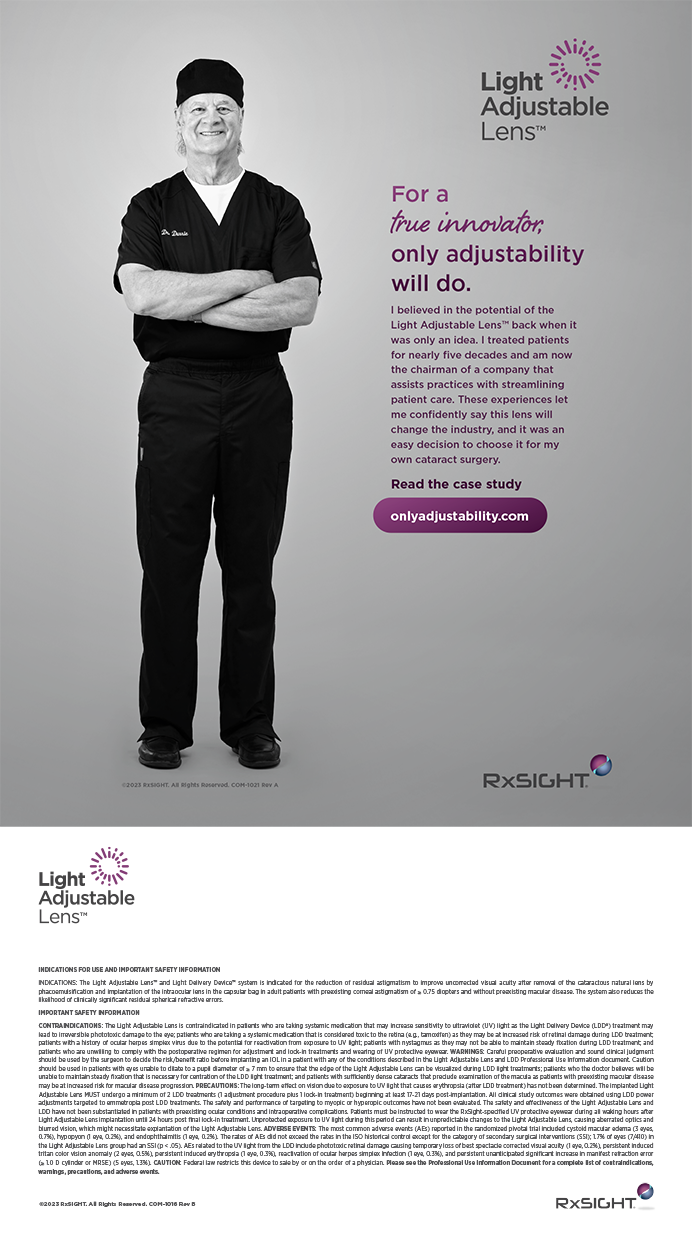In an interview with Cataract & Refractive Surgery Today, Jay C. Erie, MD, discussed the findings of a 3-year, nonrandomized study of 24 eyes that analyzed nerve fiber density after PRK to evaluate the reinnervation of human central corneas by sequential quantitative measurements of nerves viewed with confocal microscopy.
“The reason we did this study is because PRK destroys the nerves of the subbasal plexus and the anterior stroma,” Dr. Erie explained. “It leaves these sharply cut nerve bundles at the base and in the margin of the wound. We know that nerves gradually reinnervate the cornea after PRK and that sensation slowly returns, but it was unclear how quickly the nerves did return or if their density was as high as it was before PRK.”
Using a confocal microscope, the investigators examined subjects' corneas preoperatively. The participants underwent PRK (VISX Star S2 Laser;VISX, Inc., Santa Ana, CA) to treat myopia from -1.25 to -5.75 D. The epithelium was removed by a laser-scrape technique. Central corneas were scanned throughout their full-thickness by confocal microscopy before and 1, 3, 6, 12, 24, and 36 months after PRK. The investigators evaluated all confocal scans of sufficient quality in a randomized and masked procedure. Dr. Erie also noted that, of the 14 participants (three men, 11 women), five underwent reoperation and were excluded from the study's results. All visible subbasal nerves and their branches were measured in three to six scans per eye per visit. Subbasal nerve densities at all visits after PRK were compared (paired t-test, Bonferroni-adjusted for multiple comparisons) with densities before PRK. During the course of the study, Dr. Erie said no complications were experienced.
At the annual Association for Research in Vision and Ophthalmology meeting in Fort Lauderdale, Florida, on May 6, Dr. Erie delivered a presentation that showed subjects' subbasal nerve fiber bundle density had decreased 98%, 87%, 75%, and 60% at 1, 3, 6, and 12 months, respectively, after PRK when compared with preoperative levels. By the 24- and 36-month points, participants demonstrated subbasal nerve fiber densities not significantly different from preoperative values.
“What surgeons are going to find as a result of this study is that, 1 year after PRK, only half the nerves—the density of the nerves—have recovered,” Dr. Erie added. “Nerve density values do not return to preoperative levels until 2 years after PRK,” Dr. Erie said. Noting that previous studies have primarily measured sensitivity, not density, Dr. Erie explained, “Sensitivity measured with Cochet-Bonnet esthesiometry is normalized by 6 to 12 months after surgery. Even though that test of sensation is normal by 6 to 12 months after PRK, nerve density really isn't normalized until 2 years out.”
Dr. Erie said he believes the findings of this study will allow refractive surgeons to consider more closely the options available for optimal patient outcomes prior to refractive surgery.
“One of the problems with PRK, and more with LASIK, is that some patients can experience postsurgical dry eye symptoms,” Dr. Erie commented. “It has been suggested that such an experience may be due to altered corneal innervation after surgery. With PRK, we now know the nerve density returns to normal levels by 2 years. It is still unclear how long it takes for nerve density to return to normal after LASIK, although the longest quantitative study to date suggested that nerve density is also reduced more than 50% at 1 year after LASIK. So, refractive surgeons may want to take this into consideration when they are performing refractive surgery on patients who may be at higher risk of developing dry eyes afterward.”
According to Dr. Erie, what he and his fellow investigators are most proud of is that there now exists a system to quantitatively measure nerve density in the living human eye.
“It is going to allow us to now monitor nerve re-growth, and, if in the future things such as nerve growth factors become available, we will have ways to quantitatively measure the potential benefit of these new drugs,” Dr. Erie said.
In addition, he noted that he is currently involved in a study to determine corneal density reinnervation after LASIK. He said that the 1-year results of the LASIK study are now complete, with follow-up of participants expected to last as long as 10 years post-LASIK.
Jay Erie, MD, is an assistant professor in the Department of Ophthalmology, Section of Comprehensive Ophthalmology, at the Mayo Clinic in Rochester, Minnesota. He holds no financial interest in the companies or products mentioned herein. Dr. Erie may be reached at (507) 284-3701; erie.jay@mayo.edu.


